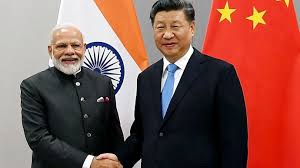
When Prime Minister Narendra Modi set foot in Tianjin for the Shanghai Cooperation Organization summit, it marked more than a diplomatic appearance. It was the first visit by an Indian leader to China in seven years, and it came against the backdrop of a complex relationship defined by history, hardened by mistrust, yet bound by economic necessity. The visit has drawn global attention, not just for the optics of a Modi–Xi meeting, but for what it reveals about how India and China manage their turbulent past, navigate a delicate present, and chart a cautious future.
Past: From Ancient Ties to Modern Friction
India and China share one of the world’s oldest civilizational connections. Centuries of cultural exchange, from Buddhism spreading to China through monks like Xuanzang, to flourishing trade across the Silk Road, once positioned the two as complementary powers. Yet, the legacy of modern geopolitics has turned this shared heritage into a contested rivalry.
The watershed moment in their modern relationship came with the 1962 border war, a conflict that still shapes national memory and strategic thinking. Since then, ties have oscillated between cautious cooperation and open hostility. Occasional breakthroughs, such as Rajiv Gandhi’s 1988 visit and the 2005 agreement on political parameters for border negotiations, raised hopes of reconciliation. However, flashpoints like Doklam in 2017 and, more severely, the Galwan Valley clashes in 2020, brought tensions back to the surface, leaving a long shadow over bilateral trust.
China’s deep strategic embrace of Pakistan has also entrenched Indian suspicion. Arms sales, infrastructure projects under the China–Pakistan Economic Corridor, and Beijing’s shielding of Islamabad at global forums have been viewed in New Delhi as deliberate attempts to contain India’s rise. For China, meanwhile, India’s closer ties with the United States, Japan, and Australia under the Quad framework feed concerns of encirclement. This duality—historic rivalry meshed with global alignments—explains why the relationship often swings between tentative cooperation and outright confrontation.
Present: An Uneasy but Necessary Engagement
Despite the scars of Galwan, Modi’s decision to attend the Tianjin summit reflects the necessity of engagement. Both economies, though competing, are deeply interlinked. India’s reliance on Chinese imports for critical sectors—ranging from pharmaceuticals and electronics to machinery and rare earths—remains substantial. Roughly 70% of India’s active pharmaceutical ingredients and nearly 90% of biosimilar components originate from China, underscoring the difficulty of rapid decoupling.
At the same time, India has sought to emerge as a manufacturing hub in its own right. Initiatives such as “Make in India” and production-linked incentives aim to draw companies diversifying away from Chinese supply chains. Notably, India has recently overtaken China as the top smartphone supplier to the U.S., signaling its potential as a “China Plus One” destination. Yet even this transition depends on continued access to Chinese intermediate goods, illustrating the paradox of competition embedded within dependence.
Diplomatically, the summit offers space for limited confidence-building. Resumption of direct flights between the two countries and plans to reopen trade routes across the Himalayas hint at a slow normalization of ties. Chinese assurances to meet India’s demand for rare earth minerals and fertilizers point to an effort by Beijing to steady the relationship at a time when its own economy faces slowing consumption and overcapacity.
Still, mistrust lingers. India remains wary of China’s assertive posture in the Indo-Pacific and its frequent border transgressions. The widening trade deficit—now nearing \$100 billion annually—further fuels political unease. For Beijing, India’s closer strategic partnership with Washington complicates its calculus. Thus, even as Modi and Xi engage in Tianjin, the tone is one of pragmatism rather than warmth.
Future: Cautious Coexistence or Strategic Competition?
Looking ahead, the trajectory of India–China relations is likely to be shaped by three interwoven dynamics.
First, border management will remain pivotal. Without a durable mechanism to prevent incidents like Galwan, mutual suspicion will continue to dominate. Talks at military and diplomatic levels could establish more reliable protocols, but genuine resolution of territorial disputes remains distant.
Second, economic rebalancing will define much of India’s approach. New Delhi’s industrial strategy aims to reduce vulnerabilities by boosting domestic capacities in electronics, pharmaceuticals, and electric vehicles. Yet the road is long. India’s target of making electric vehicles 30% of new sales by 2030, for instance, depends heavily on Chinese supplies of lithium, cobalt, and rare earth magnets. Unless India secures alternative sources or accelerates domestic mining, China will continue to hold leverage in this crucial sector.
Third, global geopolitics will frame the larger environment. As U.S.–China rivalry deepens, both Beijing and New Delhi will face choices. For India, aligning too closely with Washington could antagonize China further, while excessive hostility with Beijing risks economic blowback. For China, maintaining stable ties with India helps counterbalance Western pressure and ensures access to one of the world’s fastest-growing markets. The balance each country strikes will determine whether the relationship leans toward managed coexistence or sharper competition.
For now, the Tianjin summit is less about breakthroughs and more about restoring working channels. Symbolically, Modi’s presence signals that India is open to dialogue, but substantively, the limits are clear. Neither side is willing to sacrifice core strategic interests, yet both recognize that unbridled hostility carries costs they cannot afford.
In many ways, the India–China relationship is destined to remain a paradox: shaped by civilizational links yet constrained by geopolitics, defined by economic entanglement yet scarred by territorial disputes. The past shows cycles of cooperation followed by confrontation. The present reflects cautious engagement balanced by mistrust. The future, most likely, will be one of guarded pragmatism—where both the elephant and the dragon learn to share space without ever fully embracing.
(Source:www.cnbc.com)
Past: From Ancient Ties to Modern Friction
India and China share one of the world’s oldest civilizational connections. Centuries of cultural exchange, from Buddhism spreading to China through monks like Xuanzang, to flourishing trade across the Silk Road, once positioned the two as complementary powers. Yet, the legacy of modern geopolitics has turned this shared heritage into a contested rivalry.
The watershed moment in their modern relationship came with the 1962 border war, a conflict that still shapes national memory and strategic thinking. Since then, ties have oscillated between cautious cooperation and open hostility. Occasional breakthroughs, such as Rajiv Gandhi’s 1988 visit and the 2005 agreement on political parameters for border negotiations, raised hopes of reconciliation. However, flashpoints like Doklam in 2017 and, more severely, the Galwan Valley clashes in 2020, brought tensions back to the surface, leaving a long shadow over bilateral trust.
China’s deep strategic embrace of Pakistan has also entrenched Indian suspicion. Arms sales, infrastructure projects under the China–Pakistan Economic Corridor, and Beijing’s shielding of Islamabad at global forums have been viewed in New Delhi as deliberate attempts to contain India’s rise. For China, meanwhile, India’s closer ties with the United States, Japan, and Australia under the Quad framework feed concerns of encirclement. This duality—historic rivalry meshed with global alignments—explains why the relationship often swings between tentative cooperation and outright confrontation.
Present: An Uneasy but Necessary Engagement
Despite the scars of Galwan, Modi’s decision to attend the Tianjin summit reflects the necessity of engagement. Both economies, though competing, are deeply interlinked. India’s reliance on Chinese imports for critical sectors—ranging from pharmaceuticals and electronics to machinery and rare earths—remains substantial. Roughly 70% of India’s active pharmaceutical ingredients and nearly 90% of biosimilar components originate from China, underscoring the difficulty of rapid decoupling.
At the same time, India has sought to emerge as a manufacturing hub in its own right. Initiatives such as “Make in India” and production-linked incentives aim to draw companies diversifying away from Chinese supply chains. Notably, India has recently overtaken China as the top smartphone supplier to the U.S., signaling its potential as a “China Plus One” destination. Yet even this transition depends on continued access to Chinese intermediate goods, illustrating the paradox of competition embedded within dependence.
Diplomatically, the summit offers space for limited confidence-building. Resumption of direct flights between the two countries and plans to reopen trade routes across the Himalayas hint at a slow normalization of ties. Chinese assurances to meet India’s demand for rare earth minerals and fertilizers point to an effort by Beijing to steady the relationship at a time when its own economy faces slowing consumption and overcapacity.
Still, mistrust lingers. India remains wary of China’s assertive posture in the Indo-Pacific and its frequent border transgressions. The widening trade deficit—now nearing \$100 billion annually—further fuels political unease. For Beijing, India’s closer strategic partnership with Washington complicates its calculus. Thus, even as Modi and Xi engage in Tianjin, the tone is one of pragmatism rather than warmth.
Future: Cautious Coexistence or Strategic Competition?
Looking ahead, the trajectory of India–China relations is likely to be shaped by three interwoven dynamics.
First, border management will remain pivotal. Without a durable mechanism to prevent incidents like Galwan, mutual suspicion will continue to dominate. Talks at military and diplomatic levels could establish more reliable protocols, but genuine resolution of territorial disputes remains distant.
Second, economic rebalancing will define much of India’s approach. New Delhi’s industrial strategy aims to reduce vulnerabilities by boosting domestic capacities in electronics, pharmaceuticals, and electric vehicles. Yet the road is long. India’s target of making electric vehicles 30% of new sales by 2030, for instance, depends heavily on Chinese supplies of lithium, cobalt, and rare earth magnets. Unless India secures alternative sources or accelerates domestic mining, China will continue to hold leverage in this crucial sector.
Third, global geopolitics will frame the larger environment. As U.S.–China rivalry deepens, both Beijing and New Delhi will face choices. For India, aligning too closely with Washington could antagonize China further, while excessive hostility with Beijing risks economic blowback. For China, maintaining stable ties with India helps counterbalance Western pressure and ensures access to one of the world’s fastest-growing markets. The balance each country strikes will determine whether the relationship leans toward managed coexistence or sharper competition.
For now, the Tianjin summit is less about breakthroughs and more about restoring working channels. Symbolically, Modi’s presence signals that India is open to dialogue, but substantively, the limits are clear. Neither side is willing to sacrifice core strategic interests, yet both recognize that unbridled hostility carries costs they cannot afford.
In many ways, the India–China relationship is destined to remain a paradox: shaped by civilizational links yet constrained by geopolitics, defined by economic entanglement yet scarred by territorial disputes. The past shows cycles of cooperation followed by confrontation. The present reflects cautious engagement balanced by mistrust. The future, most likely, will be one of guarded pragmatism—where both the elephant and the dragon learn to share space without ever fully embracing.
(Source:www.cnbc.com)





